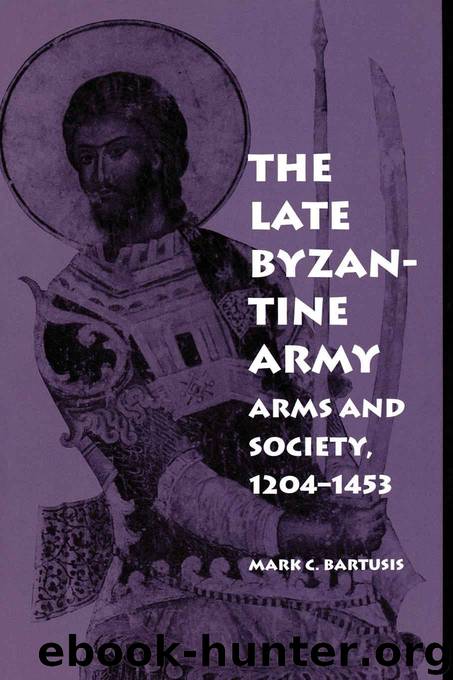The Late Byzantine Army: Arms and Society, 1204-1453 (The Middle Ages Series) by Mark C. Bartusis

Author:Mark C. Bartusis [Bartusis, Mark C.]
Language: eng
Format: azw3, epub
Publisher: University of Pennsylvania Press
Published: 2015-12-22T05:00:00+00:00
Gemistos suggests that military leaders (“archons”) and the elite (logades) of the soldiers should receive perhaps three helots, and from these each should furnish one cavalryman combining the functions of servant and soldier. The emperor, he adds, remembering his audience, should have as many helots as he needed. The well-trained troops raised by this plan would, he claims, be sufficient to defend the Isthmus through a system of rotation.12
Gemistos’ fixation on the Isthmus and the Hexamilion was limitless. In a letter to Manuel II, written slightly earlier, probably in 1415 or 1416, he raised for the first time the idea of separating the army from the taxpaying community. He writes that while it had made sense in the past for the population both to serve in the army and to pay taxes because campaigns were short, not very dangerous, and booty was plentiful, now due to the nature of campaigns and the heavy burden of taxation it was impossible to provide both. “So the soldiers must be set apart from the taxpayers, the best chosen from all, who instead of taxes provide a garrison for the Isthmus.”
He argues that this would not result in a great loss of public revenue and, carried away by enthusiasm, he volunteers to carry out the project himself. This is curious, inasmuch as there is no evidence that Gemistos had any military experience or training whatsoever. “For I offer myself to put together this army without spending more for all those recruited than all the taxes bearing on each hearth even now for the garrison of the Isthmus, and to use this revenue to provide a body of around 6,000 native soldiers, so that one thousand in rotation always could be performing garrison duty,” and all could be mobilized for emergencies. This plan, he concludes, would ensure that soldiers would be better equipped, would be more efficient because of greater specialization and would have higher morale since they would feel they were defending their own freedom, not serving as helots.13
Gemistos turned to this theme for the last time in his Address to the Despot Theodore II on the Peloponnesos, written sometime after his advice to Manuel II. His plan now became more complicated. The population still would be divided into soldiers and taxpayers (helots), but he modifies this slightly, suggesting that agricultural workers be grouped in pairs, each alternating military service and labor and functioning as reserve troops. As in his advice to Manuel, Theodore could have as many helots as he desired, some of which he would distribute to his officials and senior officers. Each of these would support an equivalent number of military clients (stratiotikoi pelatai) so the despot would not have to support them himself. Most of the army should be made up of citizens, since foreign mercenaries were unreliable. Finally, there should be no attempt to have a navy as well as an army, since that would only weaken both.14
Gemistos’ views are echoed in a letter written around 1444 to the despot Constantine by one of his students, Cardinal Bessarion.
Download
The Late Byzantine Army: Arms and Society, 1204-1453 (The Middle Ages Series) by Mark C. Bartusis.epub
This site does not store any files on its server. We only index and link to content provided by other sites. Please contact the content providers to delete copyright contents if any and email us, we'll remove relevant links or contents immediately.
| Africa | Americas |
| Arctic & Antarctica | Asia |
| Australia & Oceania | Europe |
| Middle East | Russia |
| United States | World |
| Ancient Civilizations | Military |
| Historical Study & Educational Resources |
The Radium Girls by Kate Moore(11604)
100 Deadly Skills by Clint Emerson(4683)
The Templars by Dan Jones(4555)
Rise and Kill First by Ronen Bergman(4542)
The Doomsday Machine by Daniel Ellsberg(4240)
The Rape of Nanking by Iris Chang(4016)
Killing England by Bill O'Reilly(3896)
Hitler in Los Angeles by Steven J. Ross(3795)
Stalin by Stephen Kotkin(3719)
12 Strong by Doug Stanton(3412)
Hitler's Monsters by Eric Kurlander(3152)
Blood and Sand by Alex Von Tunzelmann(3052)
Darkest Hour by Anthony McCarten(3016)
The Code Book by Simon Singh(2852)
The Art of War Visualized by Jessica Hagy(2831)
Hitler's Flying Saucers: A Guide to German Flying Discs of the Second World War by Stevens Henry(2620)
Babylon's Ark by Lawrence Anthony(2427)
The Second World Wars by Victor Davis Hanson(2419)
Tobruk by Peter Fitzsimons(2370)
